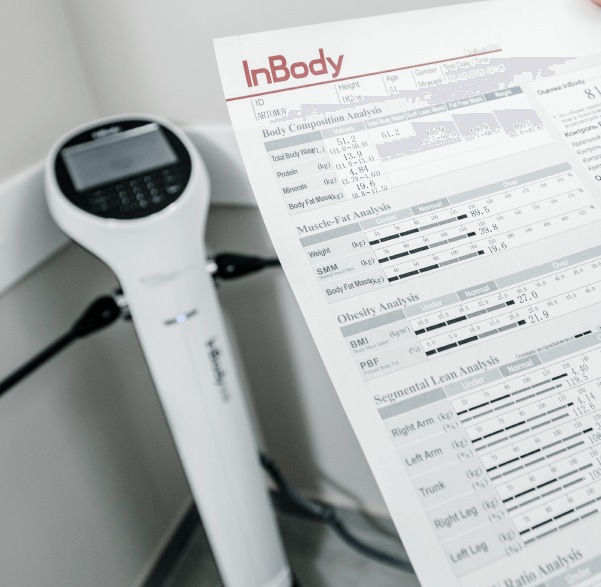Body Composition Analyser

Body Composition Analysis (BCA) reveals our total body water, protein, minerals, body fat mass, and weight. A BCA report helps your physician establish an accurate baseline and plan your health goals from there. The body composition analysis performed at regular intervals can assist in monitoring the set goals. Avoiding future complications or managing existing chronic disorders, you name it.
Request for Facility Service

Why is it important?
- Provides baseline data for nutrition counseling and treatment of obesity.
- Develop a complete physical fitness profile for clients.
- Monitor body fat loss and muscle growth due to exercise and diet.
How it works?
The given body composition analyzer works on the basis of Bioelectrical impedance analysis (BIA). BIA is a method of measuring impedance by applying alternating electrical currents to a user, measuring their volume of water through impedance values.
This noninvasive technique involves the placement of electrodes on the person’s feet, hands or both. A low-level electrical current is sent through the body and the flow of the current is affected by the amount of water in the body. BIA device measures how this signal is impeded through different types of tissue (muscle has high conductivity, but fat slows the signal down.)

Features offered
Total body water
Depicts the amount of water in the body in any form
Protein
Body fat mass
The amount of fat in the body.
Weight
The overall sum of fat mass and fat-free mass.
BMI
Minerals
Weight control
Helps you to determine the target weight, the total weight to be controlled, the amount of fat control and the amount of muscle control.
Waist-hip ratio
Segmental lean and fat analysis
Body composition history
Percent body fat
Obesity evaluation
Visceral fat level
Fat-free mass
Basal metabolic rate
Skeletal muscle mass
Skeletal Muscle Mass are the muscles that are connected to your bones and allow you to move. These are all the muscles that can be grown and developed through exercise (your pectorals, biceps, quadriceps, and so on).
Recommended calorie intake

What are the dangers of not knowing your body composition?
Complications of Obesity
- Early mortality
- Cardiovascular disease
- Hypertension
- Diabetes
- Gallbladder disease
- Cancer
- Arthritis
- Back pain
- Pregnancy complications
- Menstrual abnormalities
- Shortness of breath
- Sleep apnea
- Impaired heart function
- Impaired immune function
Complications of Low Body Fat
- Poor insulation
- Minimal energy stores
- Lack of cushioning for organs
- Poor cardiovascular function
- Prone to illness
- Poor recovery from exercise/illness
- Low testosterone
- Weak muscles
- Loss of bone density
- Amenorrhea
Complications of Low Muscle Mass (Sarcopenia)
- Frailty
- Starvation
- Poor insulin resistance/glycemic control
- Metabolic problems increase
- Osteoporosis
- Hormone dysregulation
- Low strength
- Higher risk of hospitalization/ hospital LOS

